Filter by
Type
Population
Ethnicity
-
website
(US) National Center on Birth Defects and Developmental Disabilities (NCBDDD)
Provides a wide variety of information on birth defects and disabilities.
-
book
-
article
A century of trends in adult human height
Author: NCD Risk Factor Collaboration
-
website
AnthroKids - Anthropometric Data of Children
Data from 2 investigations of Prof Richard Snyder in 1975 and 1977 when he collected anthropometric data from several thousands of USA children.
-
website
AnthroSources
Several anthropometric sources.
-
book
Arm movements in operating rotary controls
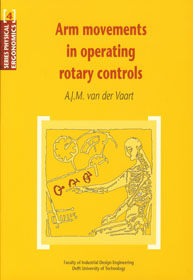 Author: van der Vaart, A.J.M.
Year: 1995
Author: van der Vaart, A.J.M.
Year: 1995Using daily-life equipment often means grasping, holding or moving knobs to control a mechanism. Little is known of the interplay between the technical characteristics of these controls, the anatomical possibilities of users, and the nature of the controlling tasks. In this series of experimental studies three forms of rotary controls (0-, T- and L-shaped) were chosen and to be handled by the arm. Rotation can be effected by forearm-rotation (supination), or by whole arm rotation (CAR) or a combination, leaving one degree of freedom extra for the task and to individual choice. Theoretically, this allows for an infinity of ways to handle the control, though it can be expected that individuals develop a more or less constant way. Can these constancies be explained by characteristics of subjects, objects and tasks?
Arm motions were opto-electronically measured and analysed. Indeed, constancies were found, the intra-individual ones proving to be more outspoken than the inter-individual similarity. With the 0-knob, offering the least constraints to grasping, three different tactics could be distinguished. The findings led to new theoretical explanations of an ergonomic nature, inclusive some practical hints concerning design and choice of rotary controls. lb be recommended to researchers in the field of movement sciences, ergonomics and equipment design.
-
website
Beperkingenpak
Het beperkingenpak is een tool voor ontwerpers en andere ondernemers waarmee ze zich kunnen inleven in ouderen en andere mensen met een fysieke beperking. Wanneer zij zelf hebben ervaren hoe het is om beperkt te zijn kunnen zij potentiële problemen onderkennen en oplossen.
-
website
CUErgo: Cornell University Ergonomics Web
A variety of ergonomics resources and tools focusing mostly on workplace ergonomics.
-
website
Cadans
In this project, state-of-the-art processing techniques are employed to structure 3D-scan databases into 3D statistical anthropometric models that provide a concise parameterization of the 3D human body shape with anthropometric parameters. These models are then made available to the product developer in standard CAD-software..
-
website
Center for Universal Design
A recommendation of articles to provide a good starting point for people wishing to learn more about Universal Design.
-
book
Child development, design implications and accident prevention
 Author: Steenbekkers, L.P.A.
Year: 1993
Author: Steenbekkers, L.P.A.
Year: 1993Knowledge of the development of children is often required during the design of daily life products, in order to make them useful, efficient and safe. These design-relevant data were, however, hardly available for children in the Netherlands. In this book results are presented of a national study on the development of several groups of variables and their mutual dependence: body dimensions, force exertion, motor performance, physical flexibility, technical comprehension, temperament and the relationships of these developmental aspects with accident liability. These variables were assessed on a large representative sample of children between 2 and 13 years of age in the Netherlands. The measurements were performed at primary schools and health care centers for infants and toddlers.
Besides, results of a pilot study are given concerning body dimensions of children between 0 and 1.5 years of age, which were measured in one province of the Netherlands.
This book can be a valuable source for designers, manufacturers, physiotherapists and physicians.
-
website
Civilian American and European Surface Anthropometry Resource Project
First 3D anthropometric data source but still costly.
-
book
Comfort in Using Hand Tools
 Author: Kuijt-Evers, L.F.M.
Author: Kuijt-Evers, L.F.M.
Year: 2007 -
website
DINBelg 2015
Anthropometric database with data for various Belgian age groups.
-
book
Design-relevant characteristics of aging users
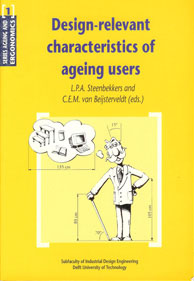 Author: Steenbekkers, L.P.A., (ed.); Van Beijsterveldt, C.E.M., (ed.)
Year: 1998
Author: Steenbekkers, L.P.A., (ed.); Van Beijsterveldt, C.E.M., (ed.)
Year: 1998Is daily-life equipment sufficiently adapted to use by the elderly? Or are product developers biased towards voting, healthy males with technical skills and insight? `When designing products to he handled at home or in a professional situation or in the public domain, designers ought to base their choices of technical properties on the capacities, habits and preferences of the user group. Although there is a continuing increase in the grey sector of society, design-relevant data on elderly users are almost nonexistent. '1 'his book attempts to narrow this gap in gerontotechnologv: product design for the elderly.
In a national study 750 subjects, who lived independently, were assessed. In total about So variables, all more or less important for product use, were measured. The sample consisted of four age groups ranging from 5o to over 8o years of age: a group of young people (20 - 30 years) was also studied for the purpose of comparison. Women and men participated in about equal numbers. The variables covered a variety of human characteristics, such as body and limb measurements, maximum forces exerted, speed of movements, eve-hand co-ordination, etc., as well as their seeing, hearing and feeling Capacities and certain aspects of memory. In addition, a questionnaire was used to probe the problems experienced with various products.
The scientific part of this study consisted of a survey of how characteristics differ between the age groups, c.q. generations, studied. Some variables proved to deteriorate earlier and some later in life, and some hardly at all. The theory that the ageing process means a slow increase in the differences between people, i.e. individualization, is confirmed. The ageing process also implies a decrease in the level of capacities: older people exhibit a growing tendency to resemble weaker young people. In most respects, however, differences between people are influenced more by sex than by age. 'l'hese general rules can provide inspiration for product innovators.
The design-oriented part of this study is found mainly in the `yellow pages'. This part contains the graphs and tables, the statistical parameters and some hints on how to use them. Design guidelines can also be found there, examples of products or components and their ergonomic, gerontotechnological points of interest. This part is meant especially for professionals who innovate, design or judge durable goods for daily life. These data can serve as checks during product development, can provide inspiration for new 'transgenerational designs', i.e. products fit for the younger and the older people in our society or special products for the elderly.
The 'Geron Group' of the Subfaculty of Industrial Design Engineering of the Delft University of Technology offers this 'databank' to designers and evaluators of products for contemplation, application, Improvement and / or augmentation.
-
website
Ergonomics4Schools
Interesting general ergonomics data.
-
website
Ergoweb
A little bit commercial information system
-
book
Fit for washing; Human factors and ergonomic evaluations of washing machines
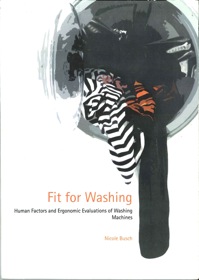 Author: Busch, N.
Author: Busch, N.
Year: 2006 -
website
Friendly Rest Rooms for Elderly People / Intelligent Toilet
Friendly Rest Rooms for Elderly People / Intelligent Toilet.
-
website
Genie project
Genie project, learning about older people
-
website
Human Factors and Ergonomics Society
The largest society is from USA and is great source of ergonomic information.
-
book
Human force exertion in user-product interaction
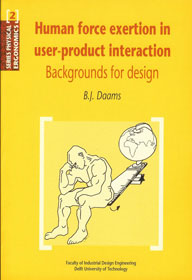 Author: Daams, B.J.
Year: 1994
Author: Daams, B.J.
Year: 1994Handling consumer durables, equipment and tools means exerting forces through the limbs. Products for daily-life use by the many should in this respect not only be adapted to healthy young males, but also weaker users. In order to realize comfortable force exertion, a product-designer ought to know and take into account which weaknesses and strenths occur in the population. Unfortunately, only few and dispersed data exist on force exertion in user-product interaction. There clearly is a need for an "Atlas of Human Force Exertion" ,which would contain all existing information on human force exertion relevant to designers. In this study a survey is given of the relevant literature and of the many factors determining maximal, submaximal and comfortable force exertion. To investigate various aspects of the Atlas, several crucial experiments are carried out, on the effects of body posture, the use of one or more joints in the arm, endurance and discomfort. An overall analysis shows the inte rrelatedness of force and anthropometric data from different parts of the human body. It is indicated how to take force exertion into account when designing and how to apply data on force, and the feasibility of a force Atlas is demonstrated. This book is of theoretical and practical interest to designers, ergonomics, physicians and physiotherapists.
-
website
Humanics Ergonomics - Ergonomics consultants
Rani Lueder provides a lot of anthropometric data on her website.
-
website
IDeA: Center for Inclusive Design and Environmental Access
The IDeA Center is dedicated to making environments and products more usable, safer and healthier in response to the needs of an increasingly diverse population.
-
website
Inclusive Design Toolkit
Every design decision has the potential to include or exclude customers. Inclusive design emphasizes the contribution that understanding user diversity makes to informing these decisions. User diversity covers variation in capabilities, needs, and aspirations.
-
website
Instituto de Biomecánica (IBV)
The Instituto de Biomecánica (IBV), is a technological centre that studies the behaviour of the human body and its interaction with products and environments. Anthropometry is a core research area to develop comfortable and healthy products for humans.
-
website
International Ergonomics Association
International ergonomics society covering about 40 national ergonomics society with a leads to national societies and technical committees and definitions.
-
website
Joint Range of Motion Study
Range of motion data of joints for several age groups.
-
website
Lichaamsafmetingen van de Belgische bevolking
Analogue of DINED data from Belgium and from wheelchair users.
-
book
Made to measure (Op maat gemaakt)
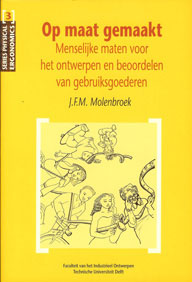 Author: Molenbroek, J.F.M.
Year: 1994
Author: Molenbroek, J.F.M.
Year: 1994This study looks at the relationship between anthropometry and industrial design engineering. Anthropometry is the study of human body dimensions, while industrial design engineering focuses on consumer durables in general use. In the world around us we can see how difficult it is for designers and people evaluating consumer durables and professional equipment to obtain and use data on human body dimensions.This difficulty has to be seen in relation to the critical function of body dimensions for comfort, safety and efficiency, and in relation to our increasing anthropometric knowledge. Possible causes of this problem are impracticable tabular data, incorrect information, and designers' ignorance. The purpose of this study is to provide a theoretical overview of and insight into the variation of anthropometric aspects of the man/product interaction and, on the basis of these, to develop an anthropometric information system that can be used by designers and product evaluators and which is easy to update.
-
website
Manikin Fetcher
Manikin Fetcher by The Open Design Lab at Penn State provides a way to find and download images and 3d models of manikins that fit anthropometric dimensions specified by the user.
-
website
NEN: Database of Norms and standards
Free access for TU Delft Students. If you're not on the campus, use the VPN to connect. It will grant you access. For more databases visit http://www.library.tudelft.nl/collecties/databases/
-
book
Productergonomie, Ontwerpen voor gebruikers
Author: Dirken, J.M. Year: 1998
-
book
Scopus: Thousands of Scientific Papers
Free access for TU Delft Students. If you're not on the campus, use the VPN to connect. It will grant you access to scopus. For more databases visit http://www.library.tudelft.nl/collecties/databases/
-
book
Sitting posture, comfort and pressure
 Author: Staarink, H.A.M.
Year: 1995
Author: Staarink, H.A.M.
Year: 1995Sitting posture, change of sitting posture and choice of a cushion are aspects which demand special attention when individuals are compelled to sit in a wheelchair. Factors which enhance comfort for able-bodied persons appear also to prevent the development of decubitus when sitting in a wheelchair. Good pressure distribution is one of the most important characteristics of a cushion. An insight is given in how a good pressure distribution can he achieved and what the effect is of different cushion characteristics and cushion systems on pressure distribution. How can a cushion be optimized for a specific individual and what is the interplay of parameters? At the same time answers to these questions produce design criteria, both for the individual wheelchair user as well as for defined user groups. Examples and results for specially developed cushions are included. This hook is recommended to advisors of wheelchairs and wheelchair cushions, occupational therapists, physiotherapists, rehabilitation consultants, suppliers and designers of seating supports.
-
website
-
book
Strength data for design safety - Phase 1
Author: UK Department of Traded and Industry
-
website
-
book
The design of home appliances for young and old consumers
 Author: Freudenthal, A.
Year: 1999
Author: Freudenthal, A.
Year: 1999Is daily-life equipment sufficiently adapted to use by the elderly? Or are product developers biased towards young, healthy males with technical skills and insight? When designing products to he handled at home or in a professional situation or in the public domain, designers ought to base their choices of technical properties on the capacities, habits and preferences of the user group. Although there is a continuing increase in the grey sector of society, design-relevant data on elderly users are almost nonexistent. This hook attempts to narrow this gap in gerontechnology: product design for the elderly.
Two classes of products that tend to cause major problems in use are consumer electronics and household appliances and their accompanying manuals. Most senior citizens cannot or will not program the channels of their TV or set the clock of the microwave oven. If such products would be designed in a way that takes into account the diminishing human capacities of the elderly, younger users would benefit as well; ease of use could be improved in new product design. Transgenerational design guidelines are needed for this purpose. A set of about one hundred new guidelines for product development and the design of product manuals is presented in this volume, the second of this series. In this volume methodological issues of user-centered design are tackled and essential product properties are described, matching users' strategics for product use and cognitive aspects, such as learning, and aspects of perception, for three age groups (the elderly, adults and teen-agers). Relating backgrounds, including ageing human capacities and changes in design methodology, are obtained from empirical research and supported by a literature survey. The guidelines and their backgrounds indicate how user problems encountered with many of the current home appliances come about, e.g., which current product details do not match psychological characteristics, and how problems can be avoided in new designs.
The guidelines are established on the basis of' results of observation studies. Subjects from three cohorts used a range of apparatus, such as washers, microwave ovens, audio equipment, and a TV-VCR combination. The guidelines were generated in various steps in which they were also tested as hypotheses. 'li) guarantee that the guidelines can be used for actual innovation projects, they need to go beyond ergonomic requirements for the elderly. True transgenerational design guidelines must also take into account the wishes and needs of other groups of consumers in the target group, such as the voting. This means that specifications on possible differences between age groups in learning to use a product, strategies of use of the product and, for that matter, preferences for functionality or aesthetics are included in the research target and indicated in the list of guidelines. Testing of the guidelines during actual innovation projects in industry was performed to evaluate and improve the guidelines.
Product developers and innovation managers are invited to implement the checklist of guidelines, to initiate or enhance their user-centered design work.
-
book
Using artificial neural networks for the transformation of human body postures based on landmarks
 Author: Zhang, B.
Author: Zhang, B.
Year: 2005 -
website
World Engineering Anthropometry Resource
International working group for anthropometry; they have a nice information system about anthropometry without help desk. I can provide passwords to Industrial Design students.